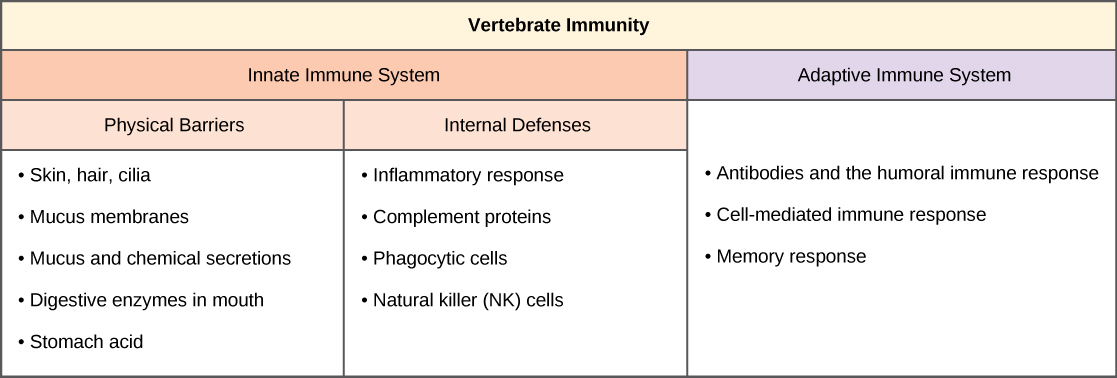| << Chapter < Page | Chapter >> Page > |
The organism possesses certain contrivances by means of which the immunity reaction, so easily produced by all kinds of cells, is prevented from acting against the organism's own elements and so giving rise to autotoxins... These contrivances are naturally of the highest importance for the existence of the individual.Paul Ehrlich, German immunologist and pharmacologist, "On Hemolysins", 1901
Although other organisms have immune responses of various types, the vertebrate immune system is the most sophisticated. The vertebrate immune system is a complex multilayered system for defending against external and internal threats to the integrity of the body. The system can be divided into two types of defense systems: the innate immune system , which is nonspecific toward a particular kind of pathogen, and the adaptive immune system , which is specific ( [link] ). Innate immunity relies on physical and chemical barriers that work on all pathogens, sometimes called the first line of defense. The second line of defense of the innate system includes chemical signals that produce inflammation and fever responses as well as mobilizing protective cells and other chemical defenses. The adaptive immune system mounts a highly specific response to substances and organisms that do not belong in the body. The adaptive system takes longer to respond and has a memory system that allows it to respond with greater intensity should the body re-encounter a pathogen, even years later. That memory is the basis for the long-term effectiveness of many vaccines.

The body has significant physical barriers to potential pathogens. The skin contains the protein keratin, which resists physical entry into cells. Other body surfaces, particularly those associated with body openings, are protected by the mucous membranes. The sticky mucus provides a physical trap for pathogens, preventing their movement deeper into the body. Some openings of the body, such as the nose and ears, are protected by hairs that catch pathogens, and the mucous membranes of the upper respiratory tract have cilia that constantly sweep pathogens trapped in the mucus coat up to the mouth. The skin and mucous membranes also create a chemical environment that is hostile to many microorganisms. The surface of the skin is acidic, which prevents bacterial growth. Saliva, mucus, and the tears of the eye contain an enzyme that breaks down bacterial cell walls. The stomach secretions create a highly acidic environment, which kills many pathogens entering the digestive system.
Finally, the surface of the body and the lower digestive system have a community of commensal microorganisms such as bacteria, archaea, and fungi (the microbiome) that coexist without harming the body. There is evidence that these organisms are highly beneficial to their host, combating disease-causing organisms and outcompeting them for nutritional resources provided by the host body. Despite these defenses, pathogens may enter the body through skin abrasions or punctures, or by collecting on mucosal surfaces in large numbers that overcome the protections of mucus or cilia.

Notification Switch
Would you like to follow the 'Principles of biology' conversation and receive update notifications?